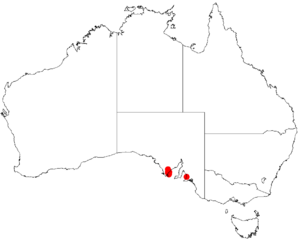Whibley wattle facts for kids
Quick facts for kids Whibley wattle |
|
|---|---|
| Conservation status | |
| Scientific classification | |
| Genus: |
Acacia
|
| Species: |
whibleyana
|
 |
|
| Occurrence data from AVH | |
The Acacia whibleyana, also known as the Whibley wattle, is a special type of shrub. It belongs to a large group of plants called Acacia and is native to South Australia.
Contents
What Does the Whibley Wattle Look Like?
This plant is a perennial shrub, which means it lives for many years. It usually grows to be about 1 to 2.5 meters (around 3 to 8 feet) tall. It can spread out quite wide, up to 4 meters (about 13 feet) across, making it look dense and bushy. Its branches are smooth and have small marks from where old leaf-like parts used to be.
Like most Acacia species, the Whibley wattle doesn't have true leaves. Instead, it has phyllodes. These are flattened stems that look and act like leaves.
The Whibley wattle blooms between August and October. It produces simple flower clusters that grow in pairs where the phyllodes meet the stem. These clusters have round flower-heads, about 2.5 to 5 millimeters (0.1 to 0.2 inches) wide. Each flower-head contains 18 to 19 beautiful golden flowers.
Where Does the Whibley Wattle Grow?
You can find the Whibley wattle growing in specific places in South Australia. It prefers areas with limestone and loam soil. Sometimes, it even grows near salty swamps. However, it's only found in the coastal areas south of Tumby Bay on the Eyre Peninsula.
How Did the Whibley Wattle Get Its Name?
This wattle was first officially described in 1995 by two scientists, Richard Sumner Cowan and Bruce Maslin. The second part of its scientific name, whibleyana, was chosen to honor David John Edward Whibley. He was a person who greatly helped us learn more about the wattles found in South Australia.
Why is the Whibley Wattle Endangered?
The Whibley wattle is currently listed as "Endangered" under a special law called the federal EPBC Act. This means there are very few of these plants left in the wild. Because it's endangered, it needs protection to help it survive and thrive for future generations.


